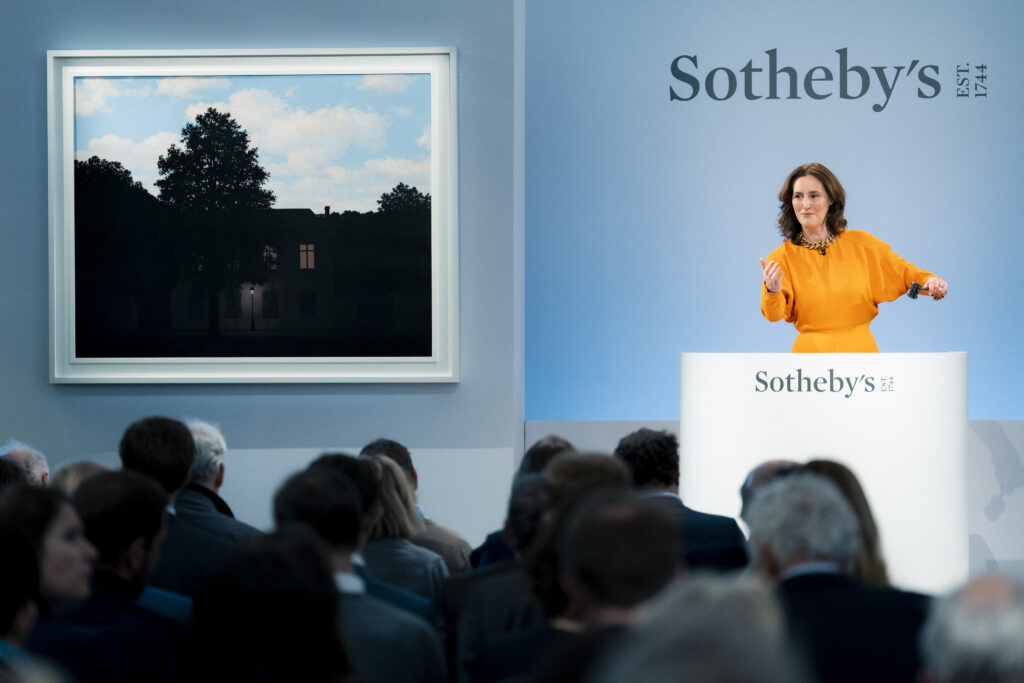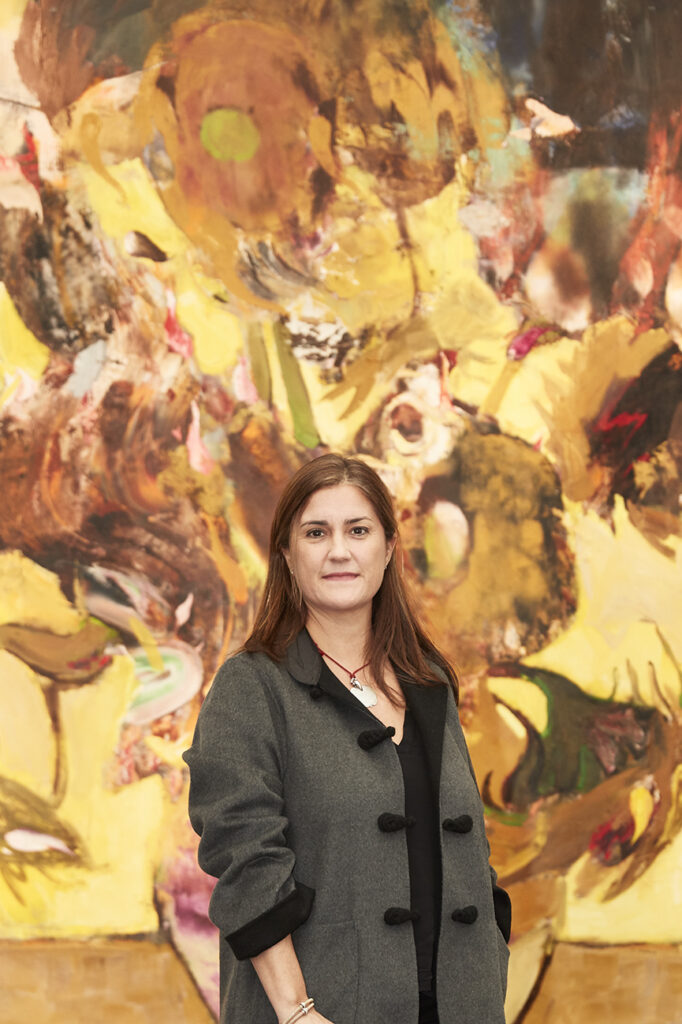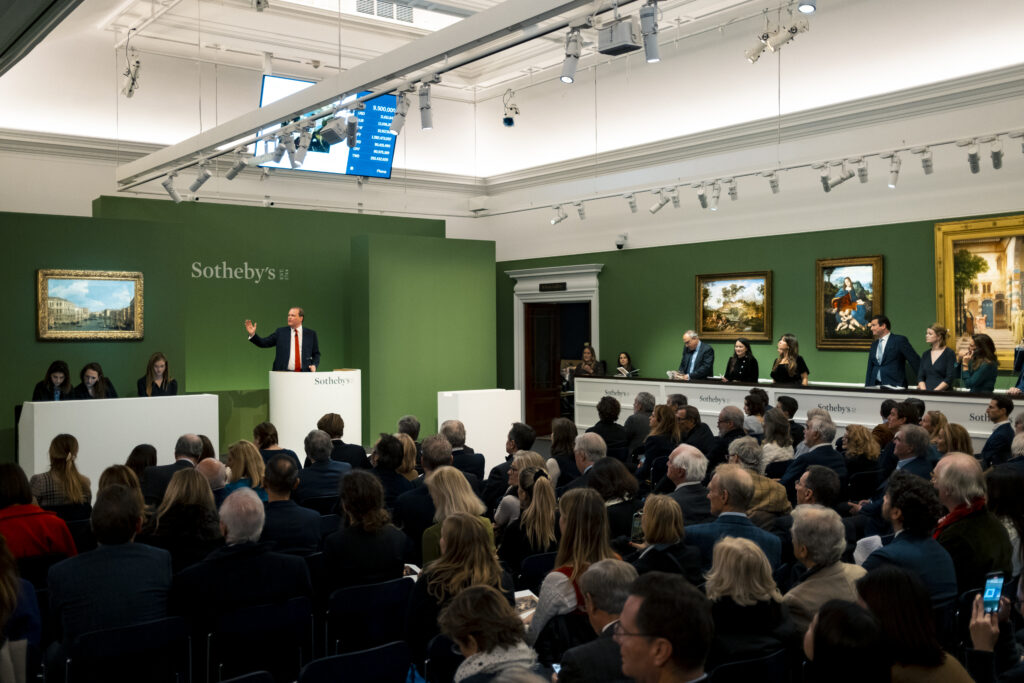FHB interview with AURORA ZUBILLAGA, CEO Sotheby’s Spain, FHB Friend
If when you think of Sotheby’s you immediately imagine an auctioneer surrounded by old paintings in an imposing room, you’re probably taking for granted all that’s actually happening behind the scenes. Aurora Zubillaga, CEO of Sotheby’s Spain, holds all the keys to unlocking the business behind the art world, with all its beauty, elegance and mystique.
ISABEL AIZPÚN
(Translated by ALEX HOSSBACH)
March 2023
Am I right in saying that Sotheby’s isn’t just about auctions?
Sotheby’s history as an art and antiquities broker goes back to 1744, when Samuel Baker first started the company. Baker started off with a book shop, where he amassed a vast personal collections before setting up his very own auction house – which soon took off. Though at first books were at the centre of operations, he quickly moved onto other sorts of items and pieces of art, which still make up the core of what we do at Sotheby’s to this day.
I’m not wrong in saying that Sotheby’s origins are very British then…
Yes! Our roots are indeed British. To a large extent we very much still feel British, given that it was in the UK that the long-standing auctioneering tradition largely evolved.
What other areas do you also cover?
We like to see ourselves as an “art business”. We don’t just set up auctions per se; we also organise private sales, exhibitions, antique car sales, wine sales… and even design and sell our own jewellery lines. Now that the market has evolved it’s no longer really a case of playing the traditional role of an auctioneer and giving an elderly lady a valuation of her antique coffee cup. Nowadays we cover anything and everything art-related, though admittedly auctions are still the centrepiece of our brand. Auctions are what Sotheby’s is known for and what reminds us of our humble origins as antique book dealers.

Having hosted many auctions yourself, how easy would you say they are to manage? Are there often any mishaps?
There are many different types of auctions and we typically hold two or three a day across Sotheby’s eight offices in New York, London, Geneva, Hong Kong, Paris, Italy, Zurich and Cologne. When running an auction, the first step is to create a catalogue, after which we tend to put individual pieces on show for around a week prior to the auction itself. You generally tend to have a good feeling for those pieces who might be overpriced, and those which are competitive and likely to receive lots of bids. Most specialists know which lot is not going sell and which one will go for 10 times its actual price, usually because a certain someone has been chasing it down for some time… So no, I wouldn’t say there are often many unexpected events, though obviously we’re not in total control of everything that happens as you never know if anyone might come along and place a bid at the last minute. I suppose that much of the magic and unpredictability which lies at the heart of any auction is still there, which is always nice to see.
You’ve lived in Mexico, the US, London and now in Madrid and in what I imagine has been a highly creative and artistic environment, which might explain why you’ve leaned towards a career in the art world. But how do you become an expert in such a difficult discipline?
I was born in Mexico to Spanish parents and moved to the US when I was 3 years old. But by the time I was 15 we had moved back to Spain, where I spent 8 years working in interior design. At some point by father suggested that I sign up for one of Sotheby’s courses, at their very own Institute of Art. I absolutely loved it and stayed in London for the duration of my first internship in the 19th century department. Coincidentally, the person who was working in the department at the time left and I took up his role. After 5 years in London, there was a change in the Sotheby’s team here in Spain and I decided to come back – this was in 2003.
Any art specialist is constantly studying, but it does depend to a degree on what kind of art specialist you are. Those who work with ancient art often hold university degrees in art history and in some cases even doctorates. But in other categories, you might be going mostly on experience. Over the years and if you truly enjoy what you’re doing, you tend to develop an eye for these kind of things.

When you’re in front of a new piece and you’re asked to make a valuation, just how important is your intuition?
Yes, a lot of the time you’re really going on hunches and gut feelings. You might not know its exact origin – it could be Flemish, Spanish or even French – but you have an inkling that it’s a quality piece. One does develop a feeling for when it’s worth doing a bit more research to find out more or when there isn’t anything to scratch.
Has the Covid-19 pandemic had as much of an impact on the international art market as it has on many other sectors?
Yes, definitely. The main challenge was having to go almost fully digital, though luckily we had already been investing in our digital infrastructure for several years. During the Covid-19 Pandemic, paintings couldn’t be moved around and people couldn’t travel, so how are you meant to sell a Goya to someone in New York? Which is where the very latest tech which Sotheby’s had been developing comes into play, to the point that at present, you can buy a painting in Paris from your home in Hong Kong.
All these advancements have done a lot in opening up the art market to people who thought that the only way of taking part in an auction was by going to a large, crowded room and bidding in person. But now the reality is that you can bid from anywhere in the world, whether you’re playing golf or fishing in the Bahamas. There are also a lot of new buyers popping up, especially in Asia, the Middle East or Latin America – people who are relatively new to the art market, tend to be fairly young and who had never previously been interested in collecting or buying art as a means of investing.
Are the young people you mention more interested in Art than they are in technology?
Art leads to status and at certain levels you have to be able to show or demonstrate one’s status. This is definitely the case for some of the newer buyers I mentioned earlier. Your new buyer isn’t your traditional collector who starts off with one or two sketches, likes them and moves on to buy an oil painting – they aim high from the outset. The thing about art is that one easily becomes hooked. Once you’ve bought seven paintings, chances are you might then decide you want to try your luck as a seller!

Are you often distrustful of new pieces when they arrive?
There are many fakes, in all categories and at all levels and you always have to make sure. The most famous works are always catalogued and verified by some of the most prominent experts. You wouldn’t be able to sell a Picasso without it having been certified by the Picasso Committee, for example. Most of the high-end pieces come with their own external expertise, which include checking whether the canvas and the craquelure match the supposed age of the painting, etc. There have been cases where supposedly old paintings were in fact two year-old fakes where the canvas had been dried out under special heat lamps. That’s where an expert’s eye to spot fakes is invaluable, as well as all the research and literature backing up his or her verdict.
It’s seems like a truly enthralling world…
The truth is that the art and antiquities market has changed a lot over recent years. Since I arrived at Sotheby’s 23 years ago, both the volumes and the way we work have changed substantially. Back in the day auction lots were smaller and the work we did was much more manual. However, Sotheby’s now sells just about anything, and one minute you find yourself making a valuation on a set of jewellery, when a piece of ancient art might come in. Given that we don’t do any auctions here in Spain, we have to do a lot more multitasking: evaluating, cataloguing and valuing works and pieces from all categories to be sent off for auction at any of our eight international auction houses.
What’s the main difference between the British and Spanish markets?
London is a very international market and is highly multicultural, with a mature and very well ingrained art collecting tradition. The Spanish market makes up but a small part of our London hub. We’ve been auctioning Spanish pieces in London for many years now and our objective is twofold. On the one hand, we aim to raise the international profile of Spanish art overseas. On the other, we like to help Spanish buyers reacquire and bring Spanish pieces back home. We used to do our own auctions in Spain until 1998 – when Sotheby’s was a very different place. Our Spanish auctions were very elegant and took place at the Ritz in Madrid, but then the company decided to centralise all auctions in larger markets.

Does living constantly surrounded by high-end art make you feel far away from reality?
The truth is that in your day to day work you’re surrounded by amazing objects and unique pieces of art. You’re working with fascinating objects on a daily basis, which I personally find extremely enriching, but by no means do we live in some sort of parallel reality. There will of course be those who do, but the vast majority of us have our feet firmly on the ground. I would say that for many people who work at Sotheby’s, art is part of their life and when they go on holiday you will find them in museums rather than shopping – at least in my case. When I travel, art comes first; whereas shopping… I might do that on the way, if there’s time. In that sense, art definitely becomes a key part of your life.
After so many years dedicated and surrounded by art, have you ever thought about trying your luck as an artist yourself?
Not as an artist, but definitely as a buyer or a collector – though we very rarely do. Sotheby’s only buys and sells on the secondary market. Though contemporary art is highly sought after, we have always stuck to the secondary market and all pieces we receive are brought to us by collectors.
The art world doesn’t seem to have been affected by the economic crisis…
Last year in 2022, Sotheby’s sold an estimated $8 billion worth of art if we count private sales, auctions and all objects: from real estate to wines or cars. It was a very solid year for Sotheby’s, thanks largely to the wide shift to the digital world I spoke of earlier. We are also starting to see NFTs and Blockchain-coded digital art arriving at our doorstep. That’s where the most innovative shift has taken place. Someone has a really good idea, and they might decide to digitalise and sell it on to someone else – ready for you to use however you wish. For sure, there are many artists who will not be successful, but there are those who will, paving the way for a wholly different dimension to art collection. You might not have a painting on your wall at home, but you’ll have links and exclusive licenses… The main element behind digital art is ensuring and encoding the security and authenticity of a given piece – as that’s really what prevents fakes or illicit re-sales.
We’ll have to wait and see what the figures for 2023 will be. Nowadays luxury is also about jewellery, Hermes handbags, wines, cars, watches… just about everything, including Michael Jordan’s trainers. The non-art market is what’s grown most recently and has tripled year-on-year. It’s not necessarily about the object itself, but about having a special and unique connection to what that person is or was. It’s truly fascinating, really…


